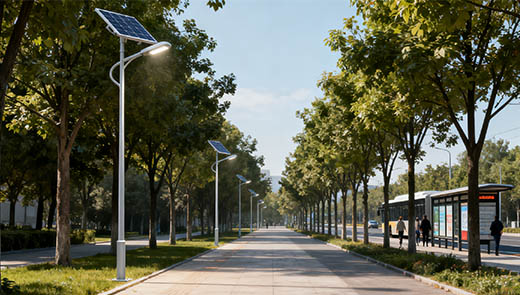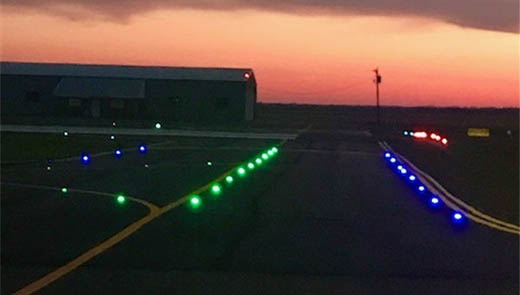Key Design Considerations for a 300W Solar Street Light
In modern urban and rural lighting solutions, 300W solar street lights are gradually becoming an important choice for road lighting due to their environmental friendliness and ease of installation. From urban main roads to rural paths, 300W solar street lights provide stable and efficient lighting, effectively enhancing nighttime travel safety. However, to ensure that 300W solar street lights perform at their best, the design phase is critical. A well-designed system not only improves energy conversion efficiency and extends the lifespan of the lights but also reduces maintenance costs, achieving a win-win outcome for both economic and environmental benefits.

Composition of 300W Solar Street Lights
Solar Panels
300W solar street lights are typically equipped with 36V, 330W high-efficiency monocrystalline silicon solar panels. Monocrystalline silicon material offers excellent photovoltaic conversion performance, enabling more solar energy to be converted into electricity. Under adequate sunlight conditions, these panels can quickly accumulate electrical energy, providing a stable power source for nighttime lighting.
Batteries
A 25.6V 75AH lithium iron phosphate (LiFePo4) battery is the commonly used energy storage device for 300W solar street lights. This battery features high energy density and stable charge/discharge performance, ensuring continuous power supply to the street light even during consecutive cloudy days or at night, thereby maintaining uninterrupted lighting. Additionally, lithium iron phosphate batteries offer a long service life and excellent safety, reducing the frequency of battery replacements and associated risks.
LED Lighting Fixtures
The LED lighting fixtures used in 300W solar street lights have a high luminous efficacy of 185 lumens per watt. Compared to traditional lighting fixtures, these high-efficiency LED fixtures provide 30,000 lumens of brightness while significantly reducing energy consumption. Additionally, LED fixtures offer advantages such as a long lifespan, fast response time, and no flicker, further enhancing the user experience of the street lights.
Controller
The intelligent maximum power point tracking (MPPT) controller serves as the “smart brain” of the 300W solar street light. It monitors light intensity and battery status in real-time, automatically adjusting charging and discharging strategies to achieve efficient energy management. For example, during periods of ample sunlight, the controller prioritizes converting solar energy into electricity and storing it in the battery; during nighttime or low-light conditions, it efficiently allocates battery power to ensure stable lighting for the street light.
What are The Key Design Considerations When Designing a 300W Solar Street Light?
Solar Panel Efficiency and Size
For a 300W solar street light, selecting high-efficiency solar panels is key to achieving maximum energy conversion. Taking monocrystalline and polycrystalline silicon panels as examples, under the same light conditions, monocrystalline silicon panels typically have a conversion efficiency 2%-5% higher than polycrystalline silicon panels. This means monocrystalline silicon panels can generate more electricity in the same timeframe, meeting the high-power requirements of street lights.
|
Solar Panel Type |
Conversion Efficiency Range |
|
Monocrystalline Panel |
18% - 22% |
|
Polycrystalline Panel |
15% - 17% |
The selection of solar panel size should take into account factors such as the lighting conditions of the installation area and the daily power consumption of the street lights. Generally speaking, areas with sufficient sunlight require relatively smaller solar panels, while areas with insufficient sunlight require larger solar panels to ensure sufficient power generation. The calculation formula is: Solar panel area = Daily power consumption / (Solar panel conversion efficiency × Average daily sunlight hours in the local area).
Battery Capacity and Lifespan
Battery capacity directly affects the continuous operating time of street lights. If the battery capacity is too small, the street light may fail to illuminate properly during consecutive cloudy days; conversely, an excessively large capacity increases costs and equipment size. For example, a 300W street light operating for 10 hours daily has a daily power consumption of approximately 3 kWh. Pairing it with a 25.6V 75AH lithium iron phosphate battery can meet the continuous power supply requirements for about 2–3 days.
An advanced Battery Management System (BMS) can precisely control the battery's charging and discharging process, preventing overcharging or over-discharging, thereby effectively extending battery life. Additionally, appropriately controlling the battery's charge/discharge depth—such as limiting it to within 80%—can significantly increase the battery's cycle life.
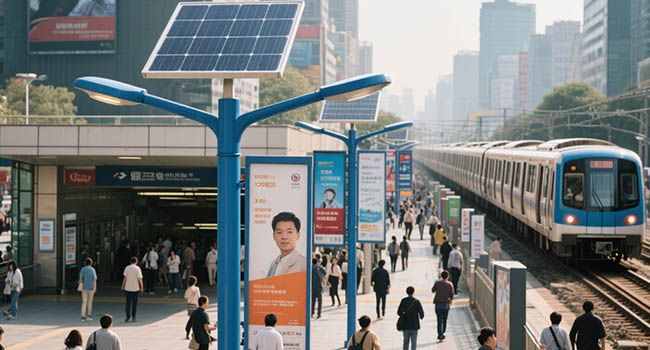
LED Luminaire Efficiency and Distribution
When selecting LED luminaires, in addition to focusing on luminous efficacy, it is also important to consider their color rendering index and color temperature. LED luminaires with a high color rendering index can more accurately reproduce object colors, enhancing nighttime visual clarity; an appropriate color temperature (such as 3000K–5000K) can ensure adequate lighting while minimizing eye strain.
By optimizing optical design and reflector structure, the divergence angle and illumination range of LED light can be precisely controlled to reduce light pollution and glare. For example, luminaires with asymmetric light distribution design can concentrate light onto the road, improving pavement illumination uniformity and ensuring the safety of pedestrians and vehicles.
Smart Lighting Controls and Monitoring
Equipped with dusk-to-dawn sensors, motion sensors, and programmable dimming functions, street lights can automatically adjust brightness based on environmental changes. When foot or vehicle traffic is low, street lights can automatically reduce brightness to save energy; when pedestrians or vehicles are detected approaching, they return to normal brightness, meeting lighting needs while achieving energy-saving goals.
The remote monitoring system can real-time obtain data such as the operational status and power consumption of street lights. In the event of a malfunction, the system can immediately issue an alert and accurately locate the fault, enabling maintenance personnel to respond swiftly, significantly reducing repair time and enhancing the reliability of street light operations.
Weatherproof and Robust Enclosure Design
Street light enclosures are typically made of aluminum alloy or stainless steel, which not only offer excellent corrosion resistance but also high strength, enabling them to withstand harsh weather conditions and external impacts. Additionally, they achieve an IP65 or higher protection rating, effectively preventing dust ingress and water penetration, ensuring the safety of internal electronic components.
Effective heat dissipation design is critical to ensuring the normal operation of LED lighting fixtures and other electronic components. By incorporating heat dissipation fins on the enclosure or using thermally conductive materials, heat can be quickly dissipated into the air, preventing component performance degradation or damage due to overheating, thereby extending the overall service life of the street light.
How do Engineers Optimize the Design to Achieve Maximum Efficiency and Performance of 300W LED Solar Street Lights for Outdoor Use?
Utilizing High-Efficiency LED Technology
Engineers rigorously test and select LED chips to ensure their luminous efficiency and lifespan meet high standards. The latest LED chip technology achieves higher luminous efficiency, with brightness improved by 20%–30% compared to earlier products under the same power, effectively reducing energy consumption per unit of lighting.
Optimizing Photovoltaic Panels for Solar Harvesting
By adjusting the installation angle and orientation of solar panels, they can receive as much sunlight as possible throughout the day. For example, in the Northern Hemisphere, solar panels are typically installed facing south at an angle similar to the local latitude to maximize the area exposed to sunlight. Additionally, advanced solar cell technologies, such as PERC (Passivated Emitter Rear Cell) technology, can further enhance the photovoltaic conversion efficiency of the panels.
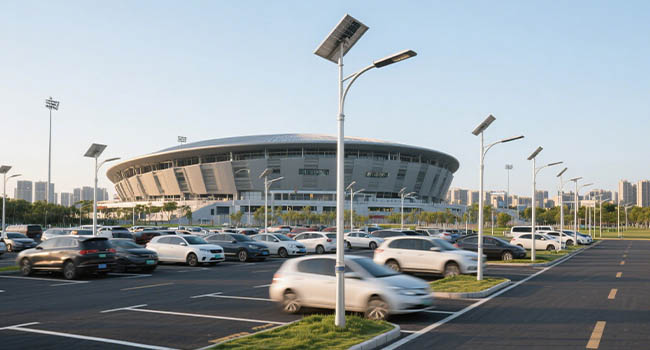
Efficient Energy Storage Solutions
In addition to lithium iron phosphate batteries, engineers are exploring other novel energy storage technologies to further improve storage efficiency and reduce costs. In terms of battery configuration, by calculating the series and parallel connections of battery packs, optimizing battery capacity and voltage matching, the stability of the energy storage system is ensured.
Intelligent Control and Monitoring Systems
Intelligent control systems utilize sensors and algorithms to achieve precise management of street lights. For example, they automatically adjust the on/off times of street lights based on the duration of daylight in different seasons; by analyzing historical electricity consumption data, they predict energy consumption trends and preemptively optimize energy allocation, further improving the operational efficiency of the street light system.
Maintenance of 300W Solar Street Lights
Clean the Solar Panels
Although rain can wash away some dust, regular cleaning of solar panels remains a necessary maintenance measure. It is recommended to clean the panels every six months, preferably in the early morning or evening to avoid high-temperature periods. During cleaning, first rinse off surface dust with a hose, then use a soft-bristle brush dipped in soapy water to gently scrub stubborn stains, and finally rinse thoroughly with clean water and dry to ensure no residue remains on the panel surface.
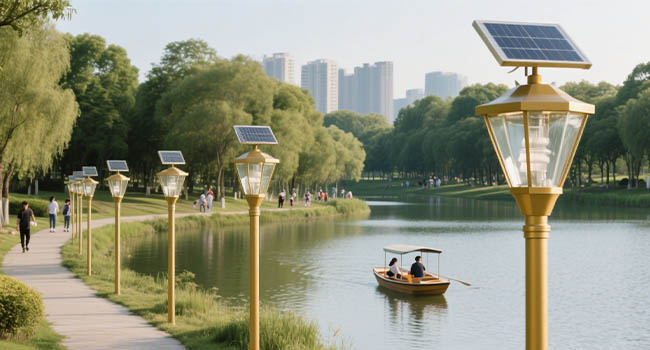
Regularly Trim the Surrounding Trees
The growth of trees and shrubs may block sunlight and affect the power generation efficiency of the panels. Therefore, it is necessary to regularly trim the plants around the street lights to ensure that the panels receive adequate sunlight throughout the day. The frequency of trimming can be determined based on the growth rate of the plants, generally checking once a month and promptly trimming newly grown branches and leaves.
Maintain or Replace the Battery
When abnormal lighting is detected, inspect the battery for corrosion. Carefully remove the battery and check the connection points and metal components for dust or corrosion. Minor corrosion can be cleaned with a soft-bristle brush, while severe corrosion requires sanding with fine-grit sandpaper. If corrosion is severe and cannot be repaired, replace the battery promptly to ensure normal operation of the street light.
Clean the Light Globes
Light globes exposed to outdoor conditions may accumulate dust and stains on their surfaces, affecting lighting performance. When the light becomes dim, remove the globe, thoroughly clean it with soapy water, dry it completely, and reinstall it to restore its transparency.
Check the Connections and Wires
Conduct a comprehensive inspection of the street light's wiring and connection points every 3–6 months. Inspect the wires for damage or aging, and check if the connection terminals are loose. If any issues are found, promptly replace damaged wires or repair the connection points to prevent the street light from turning off due to wiring faults.
Investing in a well-designed 300W solar street light can yield significant energy-saving benefits, reduce carbon emissions, and provide reliable, long-lasting lighting for urban and rural roads. With the continuous development of solar technology, energy storage technology, and smart control technology, the design of 300W solar street lights will become increasingly intelligent and efficient in the future. For example, the application of new perovskite solar cells and the integration of wireless charging technology will bring new breakthroughs to the development of solar street lights.


